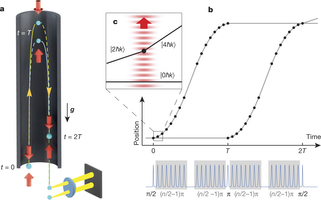This beauty was published right before the new year- quantum superposition has been extended to 54 cm, at a timescale of 1s! Let’s back up a bit- the sight/thought of quantum is always intimidating, but I guarantee you that this discovery is huge:

Quantum bits (qubits) are tiny particles that can exist in two states… or more. Just like a computer bit, these two states can be thought of as 0 or 1. Simple enough. Now what is interesting is that the particle can exist in both states at the same time. For a photon, one can consider superposition of the horizontally and vertically polarized light as the two ‘states’. For an atom, one can consider the superposition of the ground and excited energy levels as the two states there. The qubit can occupy any proportion of the two states when under superposition- based on the 3D probability of motion.
What is interesting is that upon observation, the qubit occupies only one state, albeit randomly chosen. And if two qubits are entangled, then we know that the observation of one qubit leads to the knowledge of the state of the second qubit. This Wikipedia (yes, I use Wikipedia) video helps illustrate the process: Quantum superposition
And why is this useful? Delving briefly in quantum computing, we see that the idea of a qubit potentially existing in a distribution of the two states greatly improves computation speed. By how much? If each qubit can occupy either of the two states at once, then n qubits can occupy 2^n states… aka exponential speed-up. Of course, there are physical limitations to consider when constructing a quantum computer that are nicely discussed here: YouTube: Quantum Computing
Now, let’s consider the results of this new discovery. Superposition of these individual Rb atoms has been extended to over half a meter.. which isn’t that meaningful yet considering that individual atoms are being tested here. However, new methods to sustain these quantum particles can be considered by the discovery of this group. My honest opinion is that the timescale is the key here- 1 second stability is INCREDIBLE when considering that the quantum timescales are in the pico (10^-12) seconds. This stability should be investigated further to understand how it can be replicated.
Nature: New record for Quantum Superposition
Really cool — as a tangent, it’s worth noting that quantum computers could not simply solve hard, exponentially-sized search problems in polynomial time by doing brute force search (http://www.scottaaronson.com/blog/). However, it is true that quantum algorithms do offer speed-ups, which are always at most exponential speed-ups. A good example of this is Shor’s algorithm.
LikeLiked by 1 person